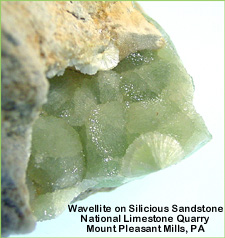When our friend, RJ Harris with the Central Pennsylvania Rock and Mineral Club (CPRMC) in Harrisburg, told me that National Limestone Quarry in Mount Pleasant Mills was producing some terrific strontianite specimens, obviously this piqued my interest. According to him, up to quarter size radial strontianite balls had become almost commonplace. But, when RJ mentioned that an area containing a large volume of grass green wavellite was recently discovered at the quarry, the location instantly shot to the top of my list of places to collect.
As fate would have it, we were invited by RJ Harris on behalf of the CPRMC to join them on their annual August picnic and field trip to Meckley's Limestone Quarry in Mandata. The event took place on Sunday, August 5th. This was the second time that we joined the club , having done so in August 2005 (click her for previous field trip report). Since we had such a fine time before, naturally we agreed to show up and even scheduled a vacation around the event. And as if hanging out with RJ and the club at their picnic and Meckley's wasn't enough, RJ graciously arranged with National Limestone's owner to have us rockhound there on Saturday, August 4th!
In order to be available bright and early on Saturday, we drove 9 hours to Selingsgrove from our home near Asheville on Friday. As we have done several times in the past, we set up our Coleman folding camper trailer at the Penn Avon Campground, that is a 1/2-hour drive from Meckley's, 35 minutes from the picnic location and only 15 minutes from National Limestone.
We met up with RJ at National Limestone at 8:00 AM Saturday. Also there were Bruce Skubbon and Ken Springer, so it was just the five of us plus Opal. It was a beautiful morning; although it was already bit warm, the relative humidity was low making for a bright blue sky. Before the day was out the temperature would rise to a near stifling 94-degrees in the shade, and the lack of clouds made it feel even hotter.
 North view from Lime Ridge of National Limestone Quarry,
North view from Lime Ridge of National Limestone Quarry,
Chestnut Ridge (middle) & Shade Mountain (distant)
(click on picture to enlarge)
National Limestone is primarily an aggregate quarry with a relatively small imprint on the surrounding farmland.

Southeast view of quarry from valley

Northeast View from Lime Ridge above quarry.
The primary rock types that are mined are limestone and a silicious sandstone. The sedimentary strata is intensely folded as a result of several major tectonic events.
 RJ's plan for the day entailed visiting three separate spots on the property where he knew that wavellite, strontianite, and calcite have been recovered. He first led us to the wavellite area on the southern flank of Lime Ridge.
RJ's plan for the day entailed visiting three separate spots on the property where he knew that wavellite, strontianite, and calcite have been recovered. He first led us to the wavellite area on the southern flank of Lime Ridge.
The strata that we worked is a silicious sandstone that contains veins and small pockets of wavellite. Although apparently still in place, the rock unit
 is a pile of rubble made up of broken rocks from pebble to large boulder size. RJ employed a sturdy potato rake to pull down and inspect rock from the steep slope while I used a prybar and a mattock to do my dirty work. We used rock hammers and sledges to bust rocks that showed any sign of wavellite on the outside.
is a pile of rubble made up of broken rocks from pebble to large boulder size. RJ employed a sturdy potato rake to pull down and inspect rock from the steep slope while I used a prybar and a mattock to do my dirty work. We used rock hammers and sledges to bust rocks that showed any sign of wavellite on the outside.
Having collected his shair of wavellite on previous occasions, Ken spent the majority of his time and stayed relatively clean hunting Devonian and Silurian fossils along the quarry roads. After about an hour of digging and finding plenty of what appeared to be nice specimens, we were honored to have the quarry owner, Eric Stahl, show up. As it turns out, Eric is one of a rare breed of owners who gets as excited as any rockhound for the minerals in his quarry. He was very knowledgeable about rocks and minerals. He informed us that turquoise had recently been identified at the quarry and pointed some of it out on a rock that Bruce had collected for wavellite.

Bruce Skubbon (left) & Eric Stahl
By noonish, we had collected plenty of wavellite. Although the rocks were heavily coated in light brown dirt, we could see lots of green in the mix. It took Chrissy and me a short while to carefully wrap and pack the rocks, but we'd rather be safe than sorry when it comes to potential damage - after all, it would be shame to ding a crystal specimen after taking such care to recover it from the earth. The following are a few representative wavellite specimens that made it home safe and sound.
Click on each specimen picture to enlarge
Click on each specimen picture to enlarge
Report continued . . . . . . .
Click Here for Next Page













